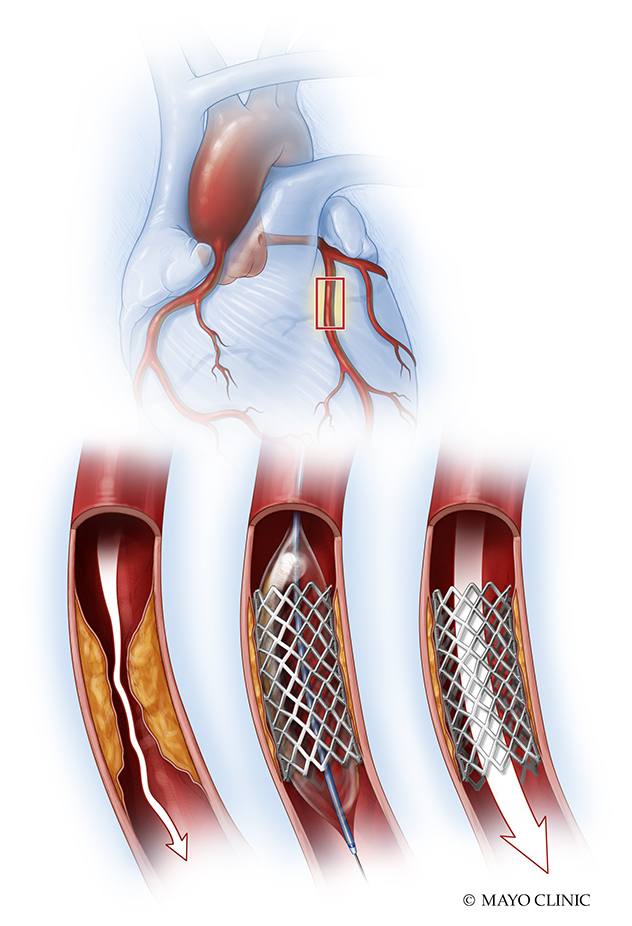-
Cardiovascular
Mayo Clinic study looks at changes in patient characteristics, outcomes for coronary revascularization
ROCHESTER, Minn. ― The most common type of heart disease ― coronary artery disease ― affects 6.7% of adults and accounts for 20% of deaths of adults under age 65. The condition builds over time as inflammation and cholesterol-containing plaques settle in the heart's arteries, where they can eventually cause narrowing and blockages that lead to a heart attack.

In addition to lifestyle changes and medication, some people undergo revascularization, which is a medical procedure to open blocked coronary arteries and restore healthy blood flow. These procedures and the demographics of patients receiving revascularizations have changed over time.
Researchers evaluated nationwide data from 2003 to 2016 to assess current trends in the risk profiles and number of patients who had revascularization to treat coronary artery disease. They also assessed the in-hospital outcomes of more than 12 million revascularizations, 72% performed through percutaneous coronary intervention (PCI) and 28% by coronary artery bypass grafting (CABG). PCI, also known as angioplasty, uses a tiny balloon catheter that is inserted in a blocked blood vessel to widen it and may involve placing a mesh stent to hold the vessel open. CABG involves taking a healthy blood vessel from elsewhere in the body and connecting it beyond the blocked artery in the heart to redirect blood flow.
The resulting study, "Trends in Characteristics and Outcomes of Patients Undergoing Coronary Revascularization in the United States, 2003–2016," was published in JAMA Network Open. Mohamad Alkhouli, M.D., is first and corresponding author on the study and Amir Lerman, M.D., is senior author on the study. Drs. Alkhouli and Lerman are Mayo Clinic cardiologists.
"There was an increase in the proportion of elderly patients (more than 85 years old), patients from racial minorities and those with lower income over the time period that we studied. Interestingly, men constituted two-thirds of the overall revascularization population, and this did not change much over time," says Dr. Alkhouli.
"We noted a substantial decrease in the number of both PCI and CABG over time, likely because patients with stable coronary artery disease are increasingly being managed medically in light of the results of clinical trials demonstrating the effectiveness of that approach," explains Dr. Alkhouli.
The percentage of people who had revascularization following a heart attack increased significantly, increasing from 22.8% from 2003 to 2007 to 53.1% from 2013 to 2016. Patients with severe heart failure tended to have a higher number of other negative health issues.
While the study was not designed to compare the two methods of revascularization, findings over time showed decreased in-hospital mortality after coronary artery bypass grafting but not after percutaneous coronary intervention. Dr. Alkhouli says this is somewhat surprising, but it may be at least partially explained by the shift in the clinical risk profile of patients undergoing percutaneous coronary intervention. He noted that although rigorous risk adjustment methodology was applied in the research, it is difficult to completely adjust for difference in risk factors in cohort studies.
"Several important questions remain open," says Dr. Alkhouli. "What can we do to further improve the outcomes of PCI, especially in the acute setting? How will the volumes and outcomes of PCI and CABG look in the next 10 years in light of the findings of the Ischemia trial? I suspect more research will emerge on these topics in the next few years."
###
About Mayo Clinic
Mayo Clinic is a nonprofit organization committed to innovation in clinical practice, education and research, and providing compassion, expertise and answers to everyone who needs healing. Visit the Mayo Clinic News Network for additional Mayo Clinic news and An Inside Look at Mayo Clinic for more information about Mayo.
Media contact:
- Terri Malloy, Mayo Clinic Public Affairs, 507-284-5005, newsbureau@mayo.edu







